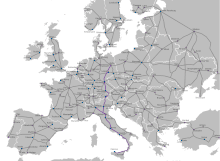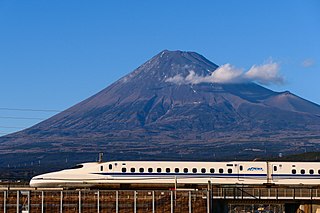
High-speed rail (HSR) is a type of rail transport network utilizing trains that run significantly faster than those of traditional rail, using an integrated system of specialized rolling stock and dedicated tracks. While there is no single standard that applies worldwide, lines built to handle speeds above 250 km/h (155 mph) or upgraded lines in excess of 200 km/h (125 mph) are widely considered to be high-speed.
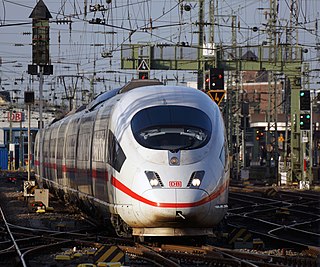
As of 2021, Germany had a railway network of 33,399 kilometres (20,753 mi), of which 20,540 kilometres (12,760 mi) were electrified and 18,556 kilometres (11,530 mi) were double track. Germany is a member of the International Union of Railways (UIC). The UIC Country Code for Germany is 80.

The Trans-European Transport Network (TEN-T) is a planned network of roads, railways, airports and water infrastructure in the European Union. The TEN-T network is part of a wider system of Trans-European Networks (TENs), including a telecommunications network (eTEN) and a proposed energy network. The European Commission adopted the first action plans on trans-European networks in 1990.

The European Train Control System (ETCS) is a train protection system designed to replace the many incompatible systems used by European railways, and railways outside of Europe. ETCS is the signalling and control component of the European Rail Traffic Management System (ERTMS).
The European Rail Traffic Management System (ERTMS) is the system of standards for management and interoperation of signalling for railways by the European Union (EU). It is conducted by the European Union Agency for Railways (ERA) and is the organisational umbrella for the separately managed parts of

Rail transport in Europe has diverse technological standards, operating concepts, and infrastructures. Common features are the widespread use of standard-gauge rail, high operational safety and a high share of electrification. Electrified railway networks operate at many different voltages, both AC and DC, varying from 750 to 25,000 volts, and signaling systems vary from country to country, complicating cross-border traffic.

The Polish railways network consists of around 18,510 kilometres (11,500 mi) of track as of 2019, of which 11,998 km (7,455 mi) is electrified. The national electrification system runs at 3 kV DC.
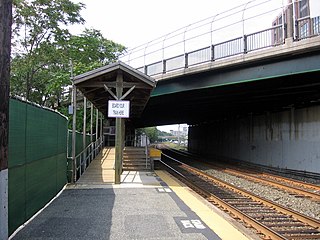
Railway platform height is the built height – above top of rail (ATR) – of passenger platforms at stations. A connected term is train floor height, which refers to the ATR height of the floor of rail vehicles. Worldwide, there are many, frequently incompatible, standards for platform heights and train floor heights. Where raised platforms are in use, train widths must also be compatible, in order to avoid both large gaps between platforms and trains and mechanical interference liable to cause equipment damage.
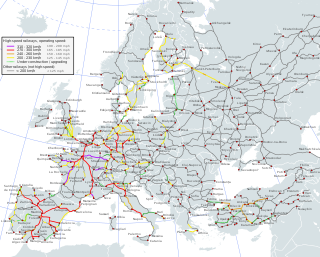
High-speed rail (HSR) has developed in Europe as an increasingly popular and efficient means of transport. The first high-speed rail lines on the continent, built in the 1970s, 1980s, and 1990s, improved travel times on intra-national corridors.

Transport in the European Union is a shared competence of the Union and its member states. The European Commission includes a Commissioner for Transport, currently Adina Ioana Vălean. Since 2012, the commission also includes a Directorate-General for Mobility and Transport which develops EU policies in the transport sector and manages funding for Trans-European Networks and technological development and innovation, worth €850 million yearly for the period 2000–2006.
A Technical Specification for Interoperability is a text provided for in European Directive 2016/797 adopted by the European Parliament and the Council of the European Union on the interoperability of the European rail system in accordance with the ordinary legislative procedure.
The Trans-European conventional rail network, together with the Trans-European high-speed rail network, make up the Trans-European Rail network, which in turn is one of a number of the European Union's Trans-European transport networks (TEN-T). It was defined by the Council Directive 2001/16/EC of 19 March 2001.
The Trans-European Rail network is made up of the Trans-European high-speed rail network as well as the Trans-European conventional rail network. The rail network is one of a number of the European Union's Trans-European transport networks (TEN-T).
The Single European Railway Directive 2012 is an EU Directive that regulates railway networks in European Union law. This recast the First Railway Directive" and consolidates legislation from each of the first to the fourth "Package" from 1991 to 2016, and allows open access operations on railway lines by companies other than those that own the rail infrastructure. The legislation was extended by further directives to include cross border transit of freight.

The Second Railway Package is a group of European Union legislation which promote common standards and open access, working towards an integrated European railway area.

The fourth railway package is a set of changes to rail transport regulation in the European Union law. It covers standards and authorisation for rolling stock; workforce skills; independent management of infrastructure; and the liberalisation of domestic passenger services in an attempt to reduce European rail subsidies.

The European Union Agency for Railways (ERA) is an agency of the European Union (EU) that sets mandatory requirements for European railways and manufacturers in the form of Technical Specifications for Interoperability (TSI), which apply to the Trans-European Rail system. The ERA publishes a document summarising the status of the TSIs. The ERA sets common safety targets, common safety methods and common safety indicators, following Directive 2004/49/EC and amendments. The ERA also hosts a number of databases, among which a register of remaining, applicable national rules. One of its primary duties is the development and implementation of the European Rail Traffic Management System (ERTMS).

The Madrid—Extremadura high-speed rail line is a rail line under construction in Spain, intended to link Madrid and Badajoz.

EN 15227 is a European standard about the crashworthiness requirements for railway vehicle bodies. It was first resolved in 2008 and it is binding since 2012 for all new vehicles in the European Union.

